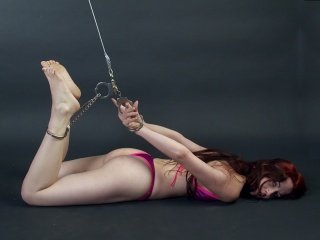 |
Peter Masters |
Peter Masters |
|
|
|||||
| About me | About this site | My books | |||||||
Bondage
| Bondage articles | |
| Rope bondage | Predicament bondage |
| Rope bondage (functional) | Suspension bondage |
| Rope bondage (decorative) | Mummification |
| Rope harness | Breast bondage |
| Metal bondage | Hog-tie |
Bondage is imposing some form of limited or total physical restraint on someone. Often it is done with rope or chain, and it can either be done free-standing or the person can be bound to something, such as a chair, tree, or specially-designed frame. Bondage is sometimes a precursor to some other activity, such as torture, flogging, or intercourse.
Contents
Why bondage?
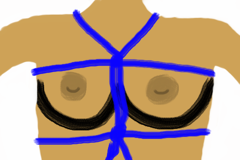
Basic breast bondage
Bondage can be done for a range of reasons. Below is a short list, but note that in any particular bondage session more than one of these reasons may be involved.
- It can be a way that one person gains power or control over their partner, and how the partner gets to experience power,
- It can a way of feeling helpless,
- It can be a means of artistic expression, where one person creates rope designs using their partner as the canvas,
- In the lead-up to some other activity, such as flogging or whipping, rope and chain can be something to struggle and strain against as part of the experience of the pain,
- It can be a convenient way to hold or support someone in a particular position or posture during some other activity. In this regard it can, for example, hold someone's legs apart during sex, or support a person during an intense flogging.
- It can be a part of a way to create pleasant or exciting sensations,
- It can be a way to create challenging situations, such as with suspension bondage,
- It can create physiological responses, with full-body restraint having been shown to cause relaxation or feelings of floating,
- Finally, in a relationship a bondage scene can be an opportunity for each partner to create an intimate experience with their partner in which each can explore and feel something powerful and important to them.
Thus, when trying to understand bondage it's important not not just to see how someone is restrained, but to learn what sort of outcome, response, or feeling they are looking to achieve and how their particular mode of bondage achieves this.
Power
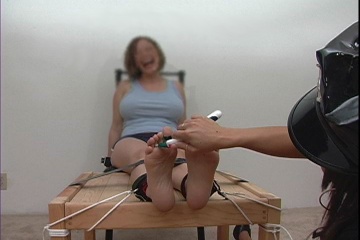
A woman tied to a table. She is being tickled and the ropes make her helpless to resist
One of the elements common to all BDSM activities is the experience of power by one person from their partner. In bondage we can find it in a few different forms:
- Firstly, skill. Bondage, particularly rope bondage, can be an exercise of skill and experience in restraining someone. If all we wanted was to bind someone so they couldn't move then chain and a few welded anchor-points would be all that we need (either that or superglue!). But frequently a bondage scene involves the interaction of the two people involved, the build-up to the scene, the process of gradually tying someone up, the physical sensations of the rope being placed and then tightened, and so on. Thus there is much more to bondage then merely immobilising someone, and the creation of a profound experience is part of the skill, ability, and power that the person doing the tying brings.
- Secondly, physical strength. For some BDSM bottoms and submissives the feeling of being physically manhandled is a power-related experience to which they strongly respond. Bondage provides an opportunity for the person doing the tying to use their strength, and the bottom or submissive to experience the power, as the ropes are placed and tightened, as the arms and legs are stretched out or pinned to the person's side, and so forth.
- Thirdly, challenge. There are many BDSM bottoms and submissives who like to be escape artists. While they may be into bondage for other reasons as well, a part of what they can get out of bondage with their partner is a battle of wits where they try to find ways out of the restraint he has put them in. This sometimes plays out as a serious game where there are frequently spoken or unspoken rules which say what the top or dominant may and may not do as part of the restraint, and which say what the bottom or submissive may or may not do to escape. For example, it might be that the dominant is not allowed to use superglue or unpickable locks, while the submissive may not be allowed to call a friend to help or use explosives.
Helplessness
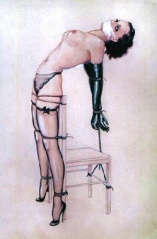
Using a high-backed chair
Helplessness and surrender can be a significant part of the experience for some bottoms and submissives. Being rendered completely helpless and being completely at the mercy of their partner can be, paradoxically, liberating and relaxing experiences for some. It allows them to escape from being themselves, from being in control, and from constantly trying to keep the rest of the world out. It can help break down psychological defences in a safe context with a trusted partner.
Art and decoration
Sometimes bondage is less an exercise in power and restraint and is more a means of artistic expression. Instead the rope and knots are used to create patterns on the body of the bottom or submissive. These can be combined with the lighting and the posture which the bottom or submissive is required to adopt to create a static tableau.
Shibari is a name given to a Japanese style of this type of bondage.
One important aspect of this use of bondage is that it serves to objectify the bottom or submissive, reducing them to the rank of canvas upon which their partner creates their rope and knot designs.
Struggle and strain
When combined with a pain-related activity---such as flogging, caning or whipping---ropes and chains commonly provide anchors which a bottom or submissive can use as they struggle, writhe and strain in response to the blows they receive. The rope and chain give them something to clench or hold onto.
Support, position-holding, and access
When rope or chains are used to hold someone immobile, it may also be that the position or posture is intended to serve some other purpose---such as rendering the bottom or submissive sexually accessible, e.g., by holding their legs apart, or to hold them steady as they function as a table or chair for their partner.
In such cases the rope and chain also frequently provides support to the bottom or submissive to allow them to remain in the desired position for long periods of time without significant strain or physical discomfort.
Pleasant and exciting sensations
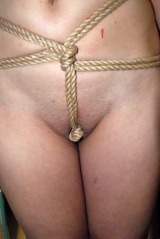
Rope bondage with a knot placed so that it rubs the clitoris
One of the advantages of using rope instead of chain in bondage scenes is that different ropes can have different textures, weight, elasticity, and other characteristics. So, beyond the perhaps overt purpose of restraining a bottom or submissive, the way the rope is used can create different sensations, some of which can be very powerful or exciting, or merely pleasant.
For example, one common component of a "tie" (the term used by some bondage enthusiasts to refer to the package of rope, knots and person they create during a scene) is a rope harness. This is a web of rope placed around the torso---from neck to crotch---which subsequently serves as tie points for restraining arms or for suspension. In the crotch area the rope of the harness usually passes from front to back. Some tops or dominants will tie knots in this particular stretch of rope and place the knots so that they rub up against their partner's genitals (e.g., clitoris).
The effect of the bondage can also change skin sensitivity. For example, increased nipple sensitivity is common during tight breast bondage.
Finally, the texture of the rope can produce pleasant or powerful sensations as it rubs or is dragged across the skin during the tying process. Many bondage tops and dominants will carry a variety of rope specifically to allow them to explore these sensations with their partner. They may have very soft and flexible rope to create feelings of firm embrace, or thin and non-stretching ropes to create biting sensations, or course and rough ropes to create irritation and prevent their partner from feeling totally comfortable.
Physiological
Research[1][2] has shown that restraint such as that used in full-body bondage or mummification leads to profound feelings of relaxation or floating in many people, even in non-BDSMers. The research shows that this effect lasts for 10 - 15 minutes, and this same period of relaxation can be observed in some BDSM bondage scenes when someone is firmly tied and left undisturbed.
Total or full restraint
Some forms of bondage are intended to completely restrict movement. Where there are external anchor points available, such as bolts on a wall or the legs of a large table, this sort of restraint can be achieved using rope attached to the bottom's or submissive's ankles and wrists to stretch them between the anchor points.
When external anchor points aren't used, full restraint can be achieved using mummification or by using a rope harness or a hog-tie. These can end up fully enclosing the bottom or submissive. In some forms, such as mummification, this can extend to so completely enclosing the submissive that only their mouth is exposed. This leads to sometimes-challenging problems related to the submissive overheating due to their inability to sweat while completely encased. This problem does not occur with rope bondage because rope and the spaces between ropes, allow the submissive's skin to breathe.
Limited restraint
Other forms of bondage and restraint are intended not so much to limit movement, but to create the feeling of being controlled and restrained.
Topical restraint
Bondage or restraint can be applied to a specific part of the body. For example, gags and other devices can be applied to a submissive's mouth to prevent them speaking, to control their ability to breathe, or to force their mouth to remain open for other "procedures".
Closer to bondage home, rope and cord can be applied to breasts and male genitals for particular psychological effect.
And devices such as cock cages and posture collars can be placed on a bottom or submissive to claim and assert control.
Books
- Screw the Roses, Send Me the Thorns: The Romance and Sexual Sorcery of Sadomasochism (Philip Miller and Molly Devon)
- Two Knotty Boys Showing You The Ropes: A Step-by-Step, Illustrated Guide for Tying Sensual and Decorative Rope Bondage (Two Knotty Boys)
- Shibari You Can Use: Japanese Rope Bondage and Erotic Macramé (Lee "Bridgett" Harrington)
- The Seductive Art of Japanese Bondage (Midori)
See also
Related
References
- ↑ [Grandin1992]
- ↑ [Krauss1987]
